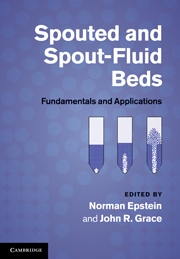Book contents
- Frontmatter
- Contents
- Contributors
- Preface
- Common nomenclature
- 1 Introduction
- 2 Initiation of spouting
- 3 Empirical and analytical hydrodynamics
- 4 Computational fluid dynamic modeling of spouted beds
- 5 Conical spouted beds
- 6 Hydrodynamics of spout-fluid beds
- 7 Spouted and spout-fluid beds with draft tubes
- 8 Particle mixing and segregation
- 9 Heat and mass transfer
- 10 Powder–particle spouted beds
- 11 Drying of particulate solids
- 12 Drying of solutions, slurries, and pastes
- 13 Granulation and particle coating
- 14 The Wurster coater
- 15 Gasification, pyrolysis, and combustion
- 16 Spouted bed electrochemical reactors
- 17 Scaleup, slot-rectangular, and multiple spouting
- 18 Mechanical spouting
- 19 Catalytic reactors and their modeling
- 20 Liquid and liquid–gas spouting of solids
- Index
- References
13 - Granulation and particle coating
Published online by Cambridge University Press: 04 February 2011
- Frontmatter
- Contents
- Contributors
- Preface
- Common nomenclature
- 1 Introduction
- 2 Initiation of spouting
- 3 Empirical and analytical hydrodynamics
- 4 Computational fluid dynamic modeling of spouted beds
- 5 Conical spouted beds
- 6 Hydrodynamics of spout-fluid beds
- 7 Spouted and spout-fluid beds with draft tubes
- 8 Particle mixing and segregation
- 9 Heat and mass transfer
- 10 Powder–particle spouted beds
- 11 Drying of particulate solids
- 12 Drying of solutions, slurries, and pastes
- 13 Granulation and particle coating
- 14 The Wurster coater
- 15 Gasification, pyrolysis, and combustion
- 16 Spouted bed electrochemical reactors
- 17 Scaleup, slot-rectangular, and multiple spouting
- 18 Mechanical spouting
- 19 Catalytic reactors and their modeling
- 20 Liquid and liquid–gas spouting of solids
- Index
- References
Summary
Introduction
Particle coating and granulation have attracted increasing attention in the past decade, with the objective of modifying particle physical and physicochemical properties. The increasing interest has appeared in several industrial sectors, such as the chemical, food, pharmaceutical, iron ore, agricultural, and nuclear industries. Cosmetics, flavorings, essences, enzymes, proteins, vegetables, seeds, fertilizers, sweets and candies, drugs, pigments, and nuclear fuel microspheres are examples of products that have been modified by coating or granulation processes.
Until the 1950s, rotary panels or drums were the predominant types of equipment for particle coating and granulation. Since then, new equipment and processes have been implemented by the pharmaceutical industry, owing to the replacement of tablets coated with sugar solutions by those coated with polymer films. In this new equipment, a suspension or solution is atomized on particles suspended by hot air. A thin film is deposited on the particle surfaces and dried by the hot air as the particles circulate through the chamber. Among the equipment, spouted beds, including Wurster coaters (Chapter 14) and other designs, are intended to improve the process performance and fluid dynamics – for example, by applying vibration and adding draft tubes.
The choice of the most adequate equipment depends on the physical properties of the particles to be coated, as well as on the coating material. The process conditions are also critical to obtain a good-quality coated product. Fluidized and spouted beds have been extensively used recently, mainly for the film coating of particles.
- Type
- Chapter
- Information
- Spouted and Spout-Fluid BedsFundamentals and Applications, pp. 222 - 237Publisher: Cambridge University PressPrint publication year: 2010



